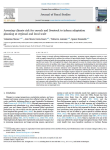Mereu V., Costa-Saura J.M., Antonio T., Donatella S. (2024). Assessing climate risk for cereals and livestock to inform adaptation planning at regional and local scale. Journal of rural studies, 01/08/2024, vol. 110, p. 103360.
https://doi.org/10.1016/j.jrurstud.2024.103360
https://doi.org/10.1016/j.jrurstud.2024.103360
| Titre : | Assessing climate risk for cereals and livestock to inform adaptation planning at regional and local scale (2024) |
| Auteurs : | V. Mereu ; J.M. Costa-Saura ; T. Antonio ; S. Donatella |
| Type de document : | Article |
| Dans : | Journal of rural studies (vol. 110, August 2025) |
| Article en page(s) : | p. 103360 |
| Langues : | Anglais |
| Langues du résumé : | Anglais |
| Catégories : |
Catégories principales 07 - ENVIRONNEMENT ; 7.6 - Changement ClimatiqueThésaurus IAMM CHANGEMENT CLIMATIQUE ; RESILIENCE ; CEREALICULTURE ; ELEVAGE ; RISQUE ; ANALYSE DU RISQUE ; REGION MEDITERRANEENNE ; ITALIE ; SARDEGNA |
| Résumé : | Climate change is strongly affecting Mediterranean agriculture, prompting urgent adaptation actions to cope with its negative impacts and to enhance the resilience of agricultural systems. Detailed climate risk analyses are essential to inform and guide decision-making on priority actions to be implemented in each territory, tailored on specific local needs. This work applied the impact chain approach to assess the climate-related risks for cereals and livestock sectors in Sardinia, Italy. Impact chains allow analysing and understanding the interrelationships between climate drivers and the related risks, supporting the development of adaptation strategies and plans. In this study, statistical socio-economic indicators were integrated with results from dynamic crop simulation models and climate change scenarios to investigate the risk components, following the IPCC framework, for the agricultural sector by 2050. The results show higher negative impacts for cereals than for livestock, with durum wheat being less climate sentitive than common wheat and maize. Overall, Sardinia has low exposure for both cereals and livestock, while adaptive capacity is criticality low, highlighting the need for urgent action. The outcomes of the analysis were elaborated at both the regional and municipal level, to provide user-friendly information for policy-makers at different administrative levels. The assessed level of risks, in terms of hazard, exposure, and vulnerability, has been used to develop the Regional Adaptation Strategy to Climate Change (SRACC) for the Sardinia region. These results may leed decision making and help planning and programming interventions also at municipal level. |
| Cote : | Réservé lecteur CIHEAM |
| URL / DOI : | https://doi.org/10.1016/j.jrurstud.2024.103360 |







